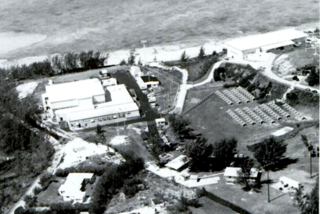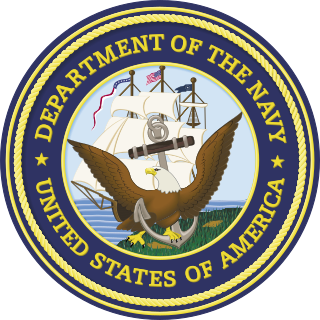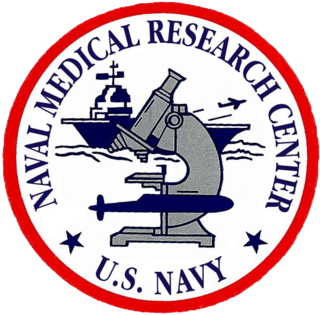Related Research Articles

The Naval Undersea Warfare Center (NUWC) is the United States Navy's full-spectrum research, development, test and evaluation, engineering and fleet support center for submarines, autonomous underwater systems, and offensive and defensive weapons systems associated with undersea warfare. It is one of the corporate laboratories of the Naval Sea Systems Command. NUWC is headquartered in Newport, Rhode Island and has two major subordinate activities: Division Newport and Division Keyport in Keyport, Washington. NUWC also controls the Fox Island facility and Gould Island. It employs more than 4,400 civilian and military personnel, with budgets over $1 billion.
Base Realignment and Closure (BRAC) is a process by a United States federal government commission to increase United States Department of Defense efficiency by coordinating the realignment and closure of military installations following the end of the Cold War. More than 350 installations have been closed in five BRAC rounds: 1988, 1991, 1993, 1995, and 2005. These five BRAC rounds constitute a combined savings of $12 billion annually.

The 2005 Base Realignment and Closure Commission preliminary list was released by the United States Department of Defense on May 13, 2005. It was the fifth Base Realignment and Closure ("BRAC") proposal generated since the process was created in 1988. It recommended closing 22 major United States military bases and the "realignment" of 33 others. On September 15, 2005, President George W. Bush approved the BRAC Commission's recommendations, leaving the fate of the bases in question to the United States Congress. Congress had a maximum of 45 days to reject the proposal by passing a joint resolution of disapproval, or the recommendations automatically enter into effect. Such a resolution was introduced to the House of Representatives on September 23, 2005, by Rep. Ray LaHood (R-IL). The House took up debate of the resolution on October 26, 2005. The resolution failed to pass by a 324-85 margin, thereby enacting the list of recommendations. The Secretary of Defense was required to begin implementing the recommendations by September 15, 2007 and to complete implementation no later than September 15, 2011.

Lakehurst Maxfield Field, formerly known as Naval Air Engineering Station Lakehurst, is the naval component of Joint Base McGuire–Dix–Lakehurst, a United States Air Force-managed joint base headquartered approximately 25 mi (40 km) east-southeast of Trenton in Manchester Township and Jackson Township in Ocean County, New Jersey, United States. It is primarily the home to Naval Air Warfare Center Aircraft Division Lakehurst, although the airfield supports several other flying and non-flying units as well. Its name is an amalgamation of its location and the last name of Commander Louis H. Maxfield, who lost his life when the R-38/USN ZR-2 airship crashed during flight on 24 August 1921 near Hull, England.

Joint Base McGuire–Dix–Lakehurst is a United States military facility located 18 miles (29 km) southeast of Trenton, New Jersey. The base is the only tri-service base in the United States Department of Defense and includes units from all six armed forces branches.

Naval Information Warfare Center Pacific, formerly Space and Naval Warfare Systems Center Pacific provides the US Navy with research, development, delivery and support of integrated command, control, communications, computers, intelligence, surveillance, and reconnaissance (C4ISR), cyber and space systems and capabilities across all warfighting domains. The only Naval technical center headquartered in a major fleet concentration area, NIWC Pacific manages strategic locations both in the Pacific theater and around the world.

Naval Facility Bermuda, or NAVFAC Bermuda, was the operational shore terminus for one of the Atlantic Sound Surveillance System (SOSUS) array systems installed during the first phase of system installation and in commission from 1955 until 1992. The true surveillance mission was classified and covered by "oceanographic research" until the mission was declassified in 1991. The system's acoustic data was collected after the facility was decommissioned until the system was routed to the central processing facility, the Naval Ocean Processing Facility (NOPF), Dam Neck, Virginia in 1994.

Naval Surface Warfare Center Crane Division is the principal tenant command located at Naval Support Activity Crane. NSA Crane is a United States Navy installation located approximately 35 miles (56 km) southwest of Bloomington, Indiana, and predominantly located in Martin County, but small parts also extend into Greene and Lawrence counties. It was originally established in 1941 under the Bureau of Ordnance as the Naval Ammunition Depot for the production, testing, and storage of ordnance under the first supplemental Defense Appropriation Act. The base is named after William M. Crane. The base is the third largest naval installation in the world by geographic area and employs approximately 3,300 people. The closest community is the small town of Crane, which lies adjacent to the northwest corner of the facility.

The Naval Air Warfare Center Training Systems Division (NAWCTSD) is an Echelon IV command of the United States Navy, reporting to the Commander, Naval Air Warfare Center - Aircraft Division (NAWCAD) at NAS Patuxent River, Maryland. NAWCTSD is located in Orlando, Florida in the Central Florida Research Park, adjacent to the University of Central Florida (UCF). The facility is a part of a larger military installation within the Central Florida Research Park known as Naval Support Activity Orlando.
The Naval Facilities Engineering Systems Command (NAVFAC) is the United States Navy's engineering systems command, providing the Navy and United States Marine Corps with facilities and expeditionary expertise. NAVFAC is headquartered at the Washington Navy Yard and is under the command of the Chief of Civil Engineers RADM Dean VanderLey

Naval Air Station Cecil Field or NAS Cecil Field was a United States Navy air base, located in Duval County, Florida. Prior to October 1999, NAS Cecil Field was the largest military base in terms of acreage in the Jacksonville, Florida area.
The 1988 Base Realignment and Closure Commission preliminary list was released by the United States Department of Defense in 1988 as part of the Base Realignment and Closure Commission. It recommended closing 17 major United States military bases.
The 1993 Base Realignment and Closure Commission preliminary list was released by the United States Department of Defense in 1993 as part of the Base Realignment and Closure Commission. It recommended closing 33 major United States military bases.
The 1995 Base Realignment and Closure Commission preliminary list was released by the United States Department of Defense in 1995 as part of the Base Realignment and Closure Commission. It recommended closing 32 major United States military bases.

The Naval Medical Research Center (NMRC) is an agency that performs basic and applied biomedical research to meet the needs of the United States Navy and United States Marine Corps. Its areas of focus include study of infectious diseases, biodefense, military medicine, battlefield medicine, and bone marrow research. NMRC is under the United States Department of the Navy's Bureau of Medicine and Surgery.

Naval Medical Research Unit Dayton (NAMRU-D) is a biomedical research laboratory of the United States Navy in Dayton, Ohio. It is one of seven subordinate commands of the Naval Medical Research Center and incorporates two research divisions. The Environmental Health Effects Laboratory was established in 1959 in Bethesda, Maryland, and moved to Dayton in 1976. NAMRU-D's predecessor organization, the Naval Aerospace Medical Research Laboratory (NAMRL), dates back to 1939 when it was established as an aviation medical research unit at Naval Air Station Pensacola, Florida. Pursuant to a 2005 Base Realignment and Closure Commission decision, NAMRL began incrementally relocating to Dayton in late 2010. and was formally disestablished at NAS Pensacola in September 2011. Despite being a Navy activity, NAMRU-D was set up on the grounds of Wright-Patterson Air Force Base at Dayton so it could be co-located with similar U.S. Air Force activities.
References
- ↑ "BASE CLOSURES AND REALIGNMENTS BY STATE: 1995, 1993, 1991, AND 1988" (PDF). Archived from the original (PDF) on 28 May 2019. Retrieved 21 June 2015.